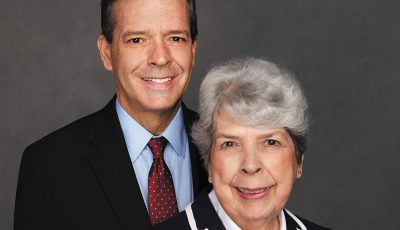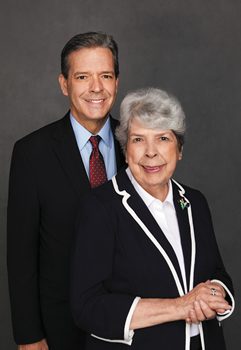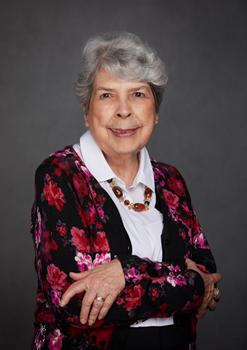

Up Close: Charles Todd
Murder and a Missing Girl in Post-World War I England
 By K.L. Romo
By K.L. Romo
The bestselling mother-son writing duo known as Charles Todd takes readers back to 1921 England in A FATAL LIE, book 23 of their gritty police procedural series featuring Scotland Yard Inspector Ian Rutledge.
Scotland Yard gives Rutledge an assignment that could just as well have been on the moon. It’s clear his supervisor is punishing him, sending him to a rural area in Wales to investigate a mysterious death. At first glance, it seems an accidental drowning. But Rutledge is an expert at deciphering clues that others miss.
A local boy had found the man floating in the river, his body damaged beyond recognition. The only evidence of who he is are the partial remnants of a tattoo and an unusual marking in the victim’s shirt. But that’s enough to lead Rutledge to the man’s identity. He also discovers the man’s young daughter disappeared a year before.
Rutledge uncovers clue upon detail upon clue which lead him in different directions, traveling back and forth between cities and towns in western England and Wales. Sometimes he’s traveling in a circle, not sure what to make of the facts that have the most tenuous of connections, the plot more twisty-turny than the country roads Rutledge travels. Can he discover what happened to the young girl and who killed her father? Is the same person responsible?
Todd skillfully weaves PTSD into the story—Rutledge believes his mate Hamish, who he killed while they were fighting at the Somme, is a constant companion. Hamish’s spirit warns him of danger and is Rutledge’s backboard for bouncing ideas back and forth and interpreting clues.
How Todd keeps up with so many intricate plot details and facts is a testament to the author’s keen attention to detail and skill in not only solving riddles, but creating them.
The Big Thrill caught up with the duo to find out how they organize so many minute facts, then piece together a puzzle sure to confound the most seasoned armchair detectives.
What do each of you contribute to the writing process? What are the logistics since you live in different states?
CHARLES: We started collaborating by long distance, and it is the way we do our best work. Even when we’re in the same house, we work in different rooms. Sort of silly to email Caroline when I could just go to the door and shout. Put us together and we get nothing done. The only exception is when we’re traveling in England—then we speak directly to each other.
CAROLINE: We learned early on that the only way our collaboration works is for each of us to know everything about what we’re doing. No “you do this and I’ll do that.” Since we don’t outline, we talk over each scene, work on what we think will happen, then compare notes and go for the best combination of ideas. That way I don’t give Gerald blue eyes on page 10 while Charles calls him Mark and gives him green eyes on page 30. This is important when we’re working with character motivation or writing an action scene. Both of us need to be in absolute agreement about what’s going to happen, otherwise, it won’t ring true.
After writing so many books for the series over the past 27 years, how do you keep the plots fresh?
CAROLINE AND CHARLES: We’re writing a series, so there are some holdover characters who appear in most of the books. And of course, there’s the main character, whether it is Rutledge or Bess Crawford. But we address each book as if it’s a standalone, as if we’re telling a story for the first time and are familiar with the character telling it. If you think, This is the 17th book, what are we going to say now?, it’s going to be stale.
We begin with the question, what do we want to explore now? We find the village or place where we think that will work out best, then look for the characters who will interact with Rutledge or Bess. It also helps to walk the ground, go to England and get to know the setting well. We may change it around a bit but not until we know why that’s necessary.
Since you’re American authors, what first inspired you to write about a Scotland Yard inspector?
CAROLINE: We’ve always loved history, and we’ve always been mystery fans, so it was natural to combine the two. Nobody was writing about the Great War, and yet it was the catalyst for most of what followed in the 20th century. But what intrigued us was what that war did to the people who lived through it. People under stress are more likely to turn to murder. And that’s what we wanted to explore: what turns ordinary people into murderers? What drives them toward killing as the only way out of a terrible situation in their lives? The odd thing is, instead of a single book, we kept finding more and more material, still finding lots to say about Rutledge and his times.
CHARLES: I think the other thing we saw was the challenge of writing about a detective—a Scotland Yard police officer—who had none of the resources that the police have today. He had experience, instinct, and intuition. He had to have an excellent knowledge of what makes people tick. So he was more interesting to write about. This is most likely linked to the fact that Caroline and I were both raised on Sherlock Holmes and Poirot and Miss Marple, all of whom had to outwit the killer they hunted. We wanted to see if we could create a character who could do the same sort of thing, but his way.
CAROLINE AND CHARLES: There’s also the fact the US was in that war for only about 18 months of actual fighting. The British were in it for four long, bloody years. If we wanted to explore the war, we had to do it in England, not here.
How have Rutledge’s personality, views, and habits changed during the 23 books in the series?
CAROLINE AND CHARLES: The series has taken place over a short period. We chose that framework because we wanted to see whether Rutledge could deal with his shell shock. Then we watched him lose the woman he loved, struggle to put that behind him, and even come to terms with his sister’s marriage. She had a new allegiance, and yet she’d been an emotional anchor for him, even though she didn’t know about his trauma. She was simply there. He wasn’t totally alone.
Many of Rutledge’s inquiries bring out different traits and emotions, different aspects of his training as a policeman, his war experiences, and his response to the individual crime he must solve. We haven’t finished with him, because he keeps surprising us.
Why did you choose to have Rutledge suffer from post-traumatic stress from World War I? And what inspired you to include the deceased Hamish as a character in the story?
CAROLINE: We chose shell shock because it was one of the terrible personal tragedies of the Great War. People viewed it as cowardice, and yet it was anything but. There were two kinds of shell shock—one quite physical, affecting the nervous system, the other something that wasn’t visible, and couldn’t be talked about or shared. One couldn’t ask for pity or help or understanding. We’ve both known people who have PTSD. Medicine has only recently been able to help them, and we thought it was time to bring it out of the shadows.
CHARLES: So here we were with a shell-shocked character. The question was: How do we show this, if Rutledge can’t talk about it to anyone? There are the nightmares and sudden lapses into the past, but we realized we needed a more focused indication. Rutledge himself sort of came up with Hamish, the man he’d killed but couldn’t face killing. The only way to deny what he’d done was to keep Hamish alive in his mind.
He was not the first soldier to do this, as we discovered when we met people whose dead buddies were as real to them as the living people around them. The key for us is that Rutledge can talk to Hamish, a dead man, when he can’t talk to the living about his war. There’s something rather awful about that sort of isolation. You either learn to cope somehow, or you go mad.
Did you travel to the aqueduct before writing the book? How does travel inform your books?
CAROLINE: We found we could indeed cross the valley of the River Dee on that aqueduct, in the same boats Rutledge crossed in, with motors now instead of horses. But that narrow walkway for the horses to pull the boats along is still there, and you can walk it. If you look down, it makes you dizzy. Just the sort of thing a mystery writer loves! There’s so much a writer can do with such an amazing experience. You have to visit them, because as these places come alive in your own mind, they come alive in the story as well.
CHARLES: You can look something up in books or on the internet and learn a great deal. But if you go into a small village on market day and talk to the people who are selling cheese or flowers or chickens, you have something in common with them for that moment, and they’ll tell you about their world.
The actual setting often has something about it that defines the mystery. Like Avebury in the last book, or Black Ascot of 1910 in another. The plot, the characters who inhabit this village, the pressures on the people there, the way the place looked in 1920—it just fires the imagination. You aren’t just creating something intriguing; you’re nailing it down in a reality that’s reflected on the page.
What are some interesting, but little-known, historical facts you’ve included in the series?
CAROLINE AND CHARLES: The Bantam soldiers in this book are real but seldom mentioned in history books. We discovered them by accident. And the same for the Black Ascot—the Ascot races where everyone wore not the latest fashions that the races are famous for, but the deepest black in mourning for the dead King Edward VII. Or the German fleet firing on the port in Madeira, killing several people. Even the use of artillery and rifle shell casings to make lighters and vases and all kinds of lovely little things.
History is full of these odd bits—you never know what you’ll find when you dig. And then you come across something that the writer’s imagination takes over, contemplating it in a mystery setting.
What is the most important piece of advice you can give other writers?
CAROLINE: Keep learning all your life. Not just about the things you are interested in, but be curious about everything. You never know when an unexpected tidbit will find its way into a book and turn a bit of plot or a piece of character detail into a far more intriguing storyline. An example—a footnote in the brochure about a house we visited in Cornwall gave us the theme for an entire book.
CHARLES: I agree with Caroline. Reading is another piece of good advice. The more you read, and the wider you read, the more you learn about the craft of writing. How others fit in clues or why that particular character stayed with you long after the book ended. Or even the reverse—why that plot angle didn’t work, or why the ending didn’t support the rest of the book.
Tell us something about yourselves your fans might not already know.
Caroline: I love travel almost as much as I love writing.
Charles: I love those signs along streets and roads that mark some historical person or event. I stop and read them, and may even go to the spot they commemorate. Great way to learn local history!
- The Big Thrill Recommends: WHAT YOU LEAVE BEHIND by Wanda M. Morris - June 27, 2024
- Sally Hepworth - May 10, 2024
- Katherine Ramsland - April 25, 2024



